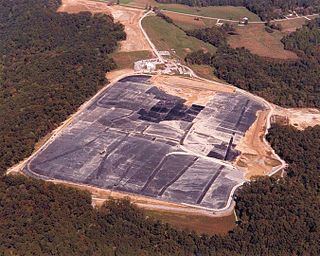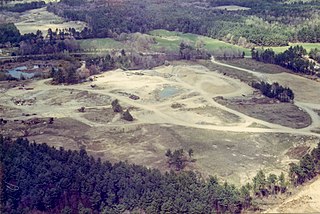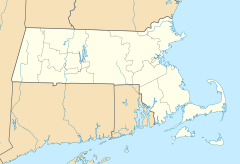
Superfund is a United States federal environmental remediation program established by the Comprehensive Environmental Response, Compensation, and Liability Act of 1980 (CERCLA). The program is administered by the Environmental Protection Agency (EPA). The program is designed to investigate and clean up sites contaminated with hazardous substances. Sites managed under this program are referred to as Superfund sites. Of all the sites selected for possible action under this program, 1178 remain on the National Priorities List (NPL) that makes them eligible for cleanup under the Superfund program. Sites on the NPL are considered the most highly contaminated and undergo longer-term remedial investigation and remedial action (cleanups). The state of New Jersey, the fifth smallest state in the U.S., is the location of about ten percent of the priority Superfund sites, a disproportionate amount.

Weldon Spring Ordnance Works (WSOW) was a 17,323-acre (70.10 km2) U.S. Government-owned, contractor-operated (GOCO) facility in St. Charles County, Missouri, 55 km west of St. Louis. The site was originally operated by the Atlas Powder Company during World War II from 1941 to 1945 to produce explosives. The Atomic Energy Commission acquired part of the property in 1955, and Mallinckrodt, Inc. processed uranium ore from 1957 to 1966 under contract. The site has been divided into several parcels, and ownership has transferred over the years. Two portions of the original WSOW property are now Superfund sites that require substantial cleanup efforts. The environmental remediation of the WSOW site is currently designated as a major project of the Defense Environmental Restoration Program of the United States Department of Defense. Part of the original property is still used by the Army Reserve as the Weldon Spring Training Area.

The Maxey Flats low-level radioactive waste (LLRW) disposal site is a Superfund site in Kentucky which served as a disposal site for low-level nuclear waste from 1963 to 1977. Investigations by the Environmental Protection Agency, among others, determined that plutonium stored at the site had migrated beyond the site's trenches, and the site was closed in 1977.

The former Lake Ontario Ordnance Works (LOOW) was a 7,500-acre (3,000 ha) military installation located in Niagara County, New York, United States, approximately 9.6 mi (15.4 km) north of Niagara Falls.
The Rolling Knolls Landfill is a landfill and Superfund site located in the Green Village section of Chatham Township in New Jersey. It is bordered on two sides by the Great Swamp National Wildlife Refuge, and was formerly known as Miele's Dump, after owner Robert Miele.

The Midnite Mine is an inactive uranium mine in the Selkirk Mountains of the state of Washington that operated from 1955 to 1965 and again from 1968 to 1981. Located within the reservation of the Spokane Tribe of Indians, it is approximately 8 miles (13 km) from Wellpinit, Stevens County. The mine was listed as a Superfund site under the Comprehensive Environmental Response, Compensation, and Liability Act of 1980 (CERCLA) on May 11, 2000. In addition to elevated levels of radioactivity, heavy metals mobilized in uranium acid mine drainage pose a potential threat to human health and the environment.
The Lipari Landill is an inactive landfill on a 6-acre (2.4 ha) former gravel pit in Mantua Township, New Jersey. It was used from 1958 to 1971 as a dump site for household and industrial wastes. Toxic organic compounds and heavy metals dumped at the site have percolated into the ground water and leached into lakes and streams in the surrounding area. The site has been identified as the worst toxic dump in the United States and was ranked at the top of the United States Environmental Protection Agency's Superfund eligibility list.

The Middlesex Sampling Plant on Mountain Avenue in Middlesex, New Jersey, is a 9.6 acres (38,800 m2) site which was initially used to stockpile pitchblende uranium ore. From 1943 to 1955, under the direction of the Manhattan Project and its successor agency, the United States Atomic Energy Commission (AEC), it was used to crush, dry, screen, weigh, assay, store, package, and ship uranium ore, along with thorium and beryllium ores, for the development of the atomic bomb.
The former Operating Industries Inc. Landfill is a Superfund site located in Monterey Park, California at 900 N Potrero Grande Drive. From 1948 to 1984, the landfill accepted 30 million tons of solid municipal waste and 300 million US gallons (1,100,000 m3) of liquid chemicals. Accumulating over time, the chemical waste polluted the air, leached into groundwater, and posed a fire hazard, spurring severely critical public health complaints. Recognizing OII Landfill's heavy pollution, EPA placed the financial responsibility of the dump's clean-up on the main waste-contributing companies, winning hundreds of millions of dollars in settlements for the protection of human health and the environment.

The Uranium Mill Tailings Radiation Control Act (1978) is a United States environmental law that amended the Atomic Energy Act of 1954 and authorized the Environmental Protection Agency to establish health and environmental standards for the stabilization, restoration, and disposal of uranium mill waste. Title 1 of the Act required the EPA to set environmental protection standards consistent with the Resource Conservation and Recovery Act, including groundwater protection limits; the Department of Energy to implement EPA standards and provide perpetual care for some sites; and the Nuclear Regulatory Commission to review cleanups and license sites to states or the DOE for perpetual care. Title 1 established a uranium mill remedial action program jointly funded by the federal government and the state. Title 1 of the Act also designated 22 inactive uranium mill sites for remediation, resulting in the containment of 40 million cubic yards of low-level radioactive material in UMTRCA Title 1 holding cells.
The Ashland/Northern States Power Lakefront Superfund site is a contaminated region of the Wisconsin shoreline of Lake Superior that is being studied for remediation by Northern States Power Wisconsin (NSPW), as well as the Environmental Protection Agency (EPA), the Wisconsin Department of Natural Resources (WDNR). This site has held a manufactured gas plant from 1845 to 1947, as well as lumber manufacturing and treatment mills for four decades at the start of the 20th century, railcar loading facilities, and a municipal landfill. Additionally, a wastewater treatment plant is located on the premises, but is not in operation. Contamination of the site is currently believed to have been caused by all the parties mentioned above, or former owners of the property whose companies are no longer in business. The area is listed as a Superfund site by the EPA under the Comprehensive Environmental Response, Compensation, and Liability Act (CERCLA). Releases of hazardous substances occurred onshore and migrated into sediment in Chequamagon Bay on Lake Superior.

West Lake Landfill is a closed, unlined mixed-waste landfill located in Bridgeton, Missouri. It was featured in the 2015 documentaries The First Secret City, The Safe Side of the Fence and the 2017 HBO documentary Atomic Homefront. Its contents have been shown to include radioactive waste; it is thus also an EPA Superfund cleanup site.

The Charles-George Reclamation Trust Landfill is a hazardous waste site located in the town of Tyngsborough, Massachusetts which is part of the Environmental Protection Agency's Superfund program. It is now the site of a 2.6 MW solar farm.

Moyer's Landfill was a privately owned landfill in Collegeville, Pennsylvania, United States. It was originally farmland outside the town. In the 1940s, the owner started accepting trash and municipal waste as a way to make additional money. The original landfill was 39 acres and did not have a liner to protect the land from contaminate. A liner was added to a new section in the late 1970s. Over time, the landfill accepted sewage, and industrial wastes which contained hazardous substances in addition to municipal waste. The site was closed by the EPA in 1981, and was one of the first "Superfund" sites added to the National Priorities List.
Coldwater Creek is a 19-mile tributary of the Missouri River in north St. Louis County in the U.S. state of Missouri. It is known to be contaminated with radioactive wastes several miles upstream of its northern mouth.
The Maywood Chemical Company processed radioactive thorium waste from 1916 through 1955 in Maywood / Rochelle Park, in Bergen County, New Jersey, United States. The United States Environmental Protection Agency (EPA) deemed Maywood Chemical a Superfund site in 1983 and has since been in the clean process.
Guam v. United States, 593 U.S. ___ (2021), was a U.S. Supreme Court case dealing with a dispute on fiscal responsibility for environmental and hazardous cleanup of the Ordot Dump created by the United States Navy on the island of Guam in the 1940s, which Guam then ran after becoming a territory in 1950 until the landfill's closure in 2011. The Supreme Court ruled unanimously that under the Comprehensive Environmental Response, Compensation, and Liability Act of 1980, Guam had filed its lawsuit to recover a portion of cleanup costs for the landfill from the United States government in a timely manner, allowing their case to proceed.
During the 20th century, a large amount of chemical waste was dumped into the Pacific Ocean within the Southern California Bight off the West Coast of the United States. Dumped materials include DDT, WW II munitions, radioactive waste, PCBs, petroleum products, and sulfuric acid.










